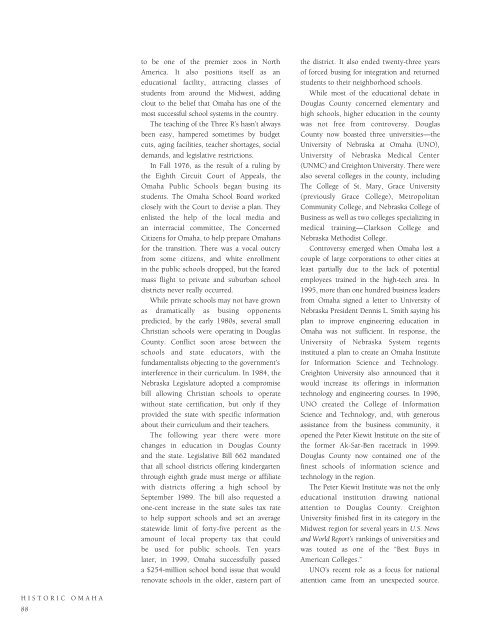Historic Omaha
An illustrated history of Omaha and the Douglas County area, paired with the histories of companies, families and organizations that make the region great.
An illustrated history of Omaha and the Douglas County area, paired with the histories of companies, families and organizations that make the region great.
You also want an ePaper? Increase the reach of your titles
YUMPU automatically turns print PDFs into web optimized ePapers that Google loves.
to be one of the premier zoos in North<br />
America. It also positions itself as an<br />
educational facility, attracting classes of<br />
students from around the Midwest, adding<br />
clout to the belief that <strong>Omaha</strong> has one of the<br />
most successful school systems in the country.<br />
The teaching of the Three R’s hasn’t always<br />
been easy, hampered sometimes by budget<br />
cuts, aging facilities, teacher shortages, social<br />
demands, and legislative restrictions.<br />
In Fall 1976, as the result of a ruling by<br />
the Eighth Circuit Court of Appeals, the<br />
<strong>Omaha</strong> Public Schools began busing its<br />
students. The <strong>Omaha</strong> School Board worked<br />
closely with the Court to devise a plan. They<br />
enlisted the help of the local media and<br />
an interracial committee, The Concerned<br />
Citizens for <strong>Omaha</strong>, to help prepare <strong>Omaha</strong>ns<br />
for the transition. There was a vocal outcry<br />
from some citizens, and white enrollment<br />
in the public schools dropped, but the feared<br />
mass flight to private and suburban school<br />
districts never really occurred.<br />
While private schools may not have grown<br />
as dramatically as busing opponents<br />
predicted, by the early 1980s, several small<br />
Christian schools were operating in Douglas<br />
County. Conflict soon arose between the<br />
schools and state educators, with the<br />
fundamentalists objecting to the government’s<br />
interference in their curriculum. In 1984, the<br />
Nebraska Legislature adopted a compromise<br />
bill allowing Christian schools to operate<br />
without state certification, but only if they<br />
provided the state with specific information<br />
about their curriculum and their teachers.<br />
The following year there were more<br />
changes in education in Douglas County<br />
and the state. Legislative Bill 662 mandated<br />
that all school districts offering kindergarten<br />
through eighth grade must merge or affiliate<br />
with districts offering a high school by<br />
September 1989. The bill also requested a<br />
one-cent increase in the state sales tax rate<br />
to help support schools and set an average<br />
statewide limit of forty-five percent as the<br />
amount of local property tax that could<br />
be used for public schools. Ten years<br />
later, in 1999, <strong>Omaha</strong> successfully passed<br />
a $254-million school bond issue that would<br />
renovate schools in the older, eastern part of<br />
the district. It also ended twenty-three years<br />
of forced busing for integration and returned<br />
students to their neighborhood schools.<br />
While most of the educational debate in<br />
Douglas County concerned elementary and<br />
high schools, higher education in the county<br />
was not free from controversy. Douglas<br />
County now boasted three universities—the<br />
University of Nebraska at <strong>Omaha</strong> (UNO),<br />
University of Nebraska Medical Center<br />
(UNMC) and Creighton University. There were<br />
also several colleges in the county, including<br />
The College of St. Mary, Grace University<br />
(previously Grace College), Metropolitan<br />
Community College, and Nebraska College of<br />
Business as well as two colleges specializing in<br />
medical training—Clarkson College and<br />
Nebraska Methodist College.<br />
Controversy emerged when <strong>Omaha</strong> lost a<br />
couple of large corporations to other cities at<br />
least partially due to the lack of potential<br />
employees trained in the high-tech area. In<br />
1995, more than one hundred business leaders<br />
from <strong>Omaha</strong> signed a letter to University of<br />
Nebraska President Dennis L. Smith saying his<br />
plan to improve engineering education in<br />
<strong>Omaha</strong> was not sufficient. In response, the<br />
University of Nebraska System regents<br />
instituted a plan to create an <strong>Omaha</strong> Institute<br />
for Information Science and Technology.<br />
Creighton University also announced that it<br />
would increase its offerings in information<br />
technology and engineering courses. In 1996,<br />
UNO created the College of Information<br />
Science and Technology, and, with generous<br />
assistance from the business community, it<br />
opened the Peter Kiewit Institute on the site of<br />
the former Ak-Sar-Ben racetrack in 1999.<br />
Douglas County now contained one of the<br />
finest schools of information science and<br />
technology in the region.<br />
The Peter Kiewit Institute was not the only<br />
educational institution drawing national<br />
attention to Douglas County. Creighton<br />
University finished first in its category in the<br />
Midwest region for several years in U.S. News<br />
and World Report’s rankings of universities and<br />
was touted as one of the “Best Buys in<br />
American Colleges.”<br />
UNO’s recent role as a focus for national<br />
attention came from an unexpected source.<br />
HISTORIC OMAHA<br />
88
















